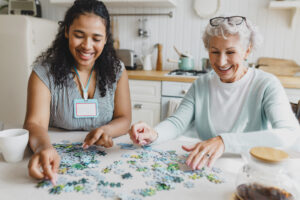For thousands of years, we humans have used speech to make ourselves understood. In fact, this is one of the major things that separates us from non-human animals. Maybe that’s why there is almost nothing as exasperating as when others can’t understand our speech. For an Alzheimer’s or dementia patient, this is an all too common scenario. This type of patient’s capacity for speech, language, and processing thought usually becomes diminished over time and can lead to an increase in dementia-related behaviors. Such behaviors may include crying, yelling, and striking things in an attempt to be understood or vent their frustration.
Unfortunately, communication difficulties work both ways. Often, those looking after the senior can’t make themselves understood either. This can be especially detrimental if you’re trying to convince your loved one to do things like eat, take medication, or let the doctor examine them. However, there are ways to improve caregiver communication. Read on for some helpful ideas for talking to someone with dementia.
Be patient
Patience is probably the hardest caregiver communication technique to follow when working with elderly dementia patients. However, it is also one of the most important. Try to listen actively to the senior while maintaining eye contact and without interrupting. If the person is struggling to find the right word or phrase, or remember what they want to say, just offer reassurance. Encourage the senior to continue trying to communicate their thoughts bearing in mind they may need extra time to understand and process what you said.
Avoid criticizing, correcting, or arguing
As tempting as it is to correct a person with dementia, it’s important that you try not to. Instead, listen and try to determine the meaning or feeling behind their communication, which is often more important that verbal accuracy. If you don’t agree with something they’ve said, it helps just to let it go. Arguing may increase their agitation level, leading to a breakdown in communication and increased negative behaviors.
Guess again
Guessing at the meaning of the senior’s incorrect word or phrase may prove useful on occasion. Although this may seem tedious for both of you, often it is the only way to discern what your loved one is trying to say.
Keep it short and simple
Using short, simple words and sentences is a key caregiver communication technique. In addition, speak slowly and clearly, making one statement (or asking one question) at a time. Any more than this will probably only confuse and overwhelm your loved one with dementia.
Turn negatives into positives
Instead of saying, “Don’t do that,” say things like, “Here — do this.” For some reason, dementia patients have an easier time understanding instructions phrased positively rather than as a negative.
Be aware of body language
Although dementia patients often have trouble understanding written and spoken language, they retain perception of body language. It is often much easier for them to comprehend non-verbal cues. Try pointing to what you think they want or ask them to do so. In addition, your loved one will likely be able to pick up on your mood and attitude even if you don’t verbalize your feelings. For this reason, try not to appear upset, frustrated, or angry in front of your loved one as you may find them mirroring these emotions back at you.
Caregiver communication is a marathon – not a sprint
The sad fact is that there is no one full-proof technique when it comes to communication with a dementia patient as a caregiver. Many times, a trial-and-error approach is needed to see what works for you and your aging loved one. In addition, certain techniques may work at certain times, but not at others. If your loved one’s dementia is progressive, after a while, only the most basic communication methods will work. However, until that happens, these tips may allow you and your loved one to enjoy a greater level of interaction and engagement for as long as possible.
If you are unsure of how to best help an aging loved one, the trained and compassionate staff at the Institute on Aging is here to help you make a decision about best at-home senior care. Contact us to find out more.







